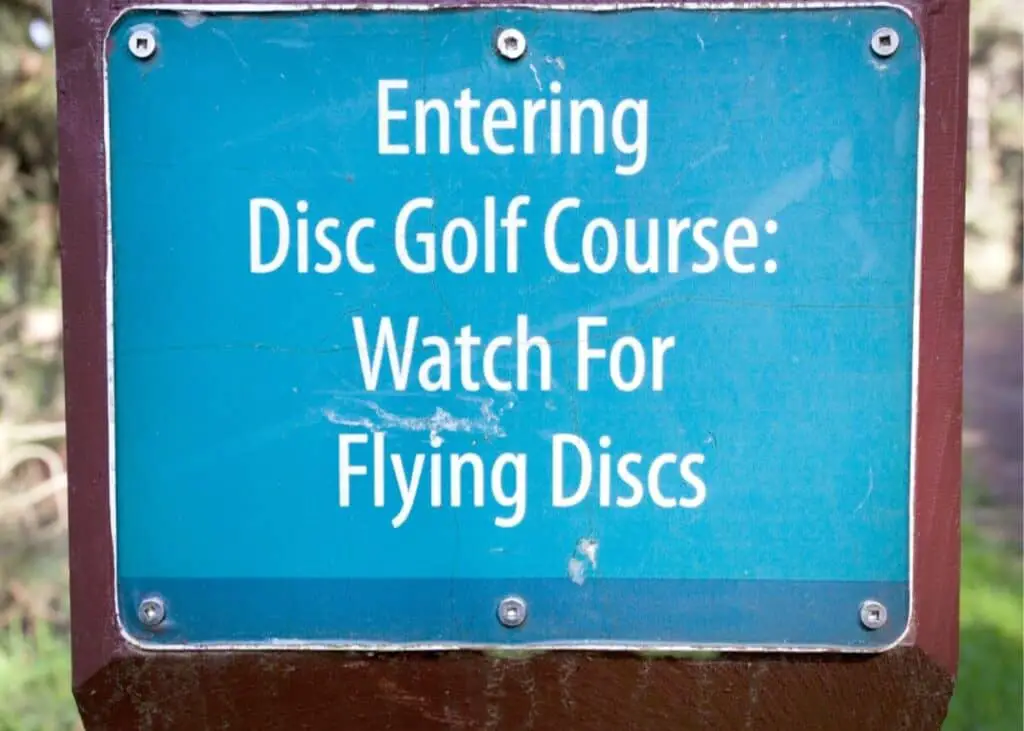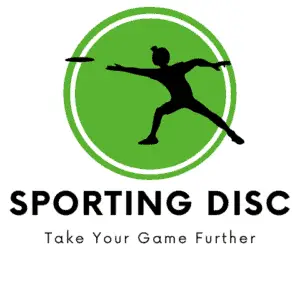As a beginner playing disc golf, it’s hard to know where to gauge your skill level. How do you know what is (or isn’t) a good drive?
I’ve set out to identify what an average driving distance is for a beginner playing disc golf. I’ll also cover some ways to improve your drive if you fall below the average.
Table of Contents
Here’s How Far a Beginner Should Drive in Disc Golf
A beginner player who is just learning to play disc golf can be expected to throw a driver between 175 to 250 ft. Beginners who have played disc golf for 1 to 2 years can be expected to throw between 200 to 300 ft. The average Open player in the professional division can throw a driver 325 to 400 ft.
In this post, I’ll give some examples of average disc golf drive distances and how you can improve your drive as a beginner.

What is a Good Drive in Disc Golf?
The PDGA divides players into different categories based on their skill level and ratings. Drive distance is a metric they use to differentiate players into these different categories.
The categories the PDGA lists are:
- Novice
- Recreational
- Intermediate
- Advanced
These four main categories make up the Amateur Division. As you can imagine, the advanced level is at the top of the Amateur Division.
If you’re an Amateur, a good drive would be 300 to 450 feet. Provided that you are under 40 years of age.
In the Professional Division, a good disc gold drive distance will be a minimum of 350 feet. Many top professional players can drive over 400 feet consistently.
A world-class Open player can top out at 550 to 600 feet for their drives.
What is an Average Disc Golf Drive?
An average disc golf drive for an Amateur player will be in the range of 300 feet in distance. Learning the necessary skills to throw a driver this far can take 2-3 years of consistent practice and play.
For women, the average disc golf drive is in the range of 200 to 250 feet.
The PDGA defines a throw of this distance for women as being an intermediate to advanced player, with 2-3 years of experience and practice.
Factors That Can Affect Total Drive Distance
Arm Speed Limitations
Arm speed is a concept that I found harder to understand. It’s easy to associate arm speed with how hard you throw the disc.
Arm speed is increased through repetition and repeating proper form when throwing a driver in disc golf. You’ll probably find that your arm speed starts to increase the more reps you get through practicing and playing disc golf.
It’s a natural progression for arm speed to increase the more experience you have.
One tip is to keep the nose of the disc tilted down when driving the disc.
Technique and Form
No beginner disc golf player is going to have perfect form. But there are some simple changes that you can make that will add some distance to your drive if they are done properly.
The first is technique and form. The X-step is a good overall technique to learn for throwing a driver. It gives you momentum and generates the power from your legs and hips that will then transfer into your drive.
Making sure that your feet are planted properly during your X-step is crucial to a powerful drive and easy to fix if you’re doing it wrong.
Be sure that the toes of your back foot are in-line with the heel of your plant foot. This will put your body and hips in a loaded position that will generate power through the drive.
Reduce Off-Axis Torque
Off-axis torque or OAT is a complicated way to say that there is some force being applied to the disc that does not allow for clean rotation of the disc.
In the case of disc golf, that force is usually up or down on the disc. That force will destabilize and create that familiar fluttering when the disc is thrown.
A disc that is flying off-axis will flutter in the air. This fluttering or wobbling is bad because it will destabilize the disc while in flight, create drag, and cause the disc to be more or less overstable than it would if it was thrown cleanly.
A disc can wobble when driving, laying up, or on any type of throw. Off-axis torque can affect your game from driving to putting.
If you suspect off-axis torque is affecting your drive, see these 3 ways to fix the wobbling and drive further.
How Can I Improve My Disc Golf Drive Distance?
1. Increase Arm Speed
One of the most important factors in adding distance to a drive is to increase arm speed. Most people will believe that adding arm speed means muscling up and throwing the driver as hard as humanly possible.
But, muscling up on the disc will not increase your arm speed or be a substitute for arm speed when throwing a driver on the course.
Arm speed doesn’t come by throwing the disc harder.
Speed will come from full arm extension, rotation of the hips, and the timing of these different movements coming together.
2. Work on Footwork
Beginners who want to drive a disc farther will logically think that getting a running start on the tee will provide them with the momentum needed to launch their throw further down the fairway.
The truth is that getting a running start won’t allow you to throw further at all.
You’ll need to work on proper footwork if you want to drive further.
The basic footwork move when driving is called the “X Step”. Using the X step will put your feet in the right spot and get your body into a loaded position to create the most power and speed behind the drive.
Your legs and your hips will provide the power when it comes to driving the disc, so footwork is key to maximizing the potential power. Here is how to perform an X step properly.
3. Drive With a Putter First
A putter is not designed to fly far or particularly fast, so why would you want to play a round of disc golf using only a putter?
Playing with only a putter is going to force you to dial in your technique, form, and mechanics to make consistent shots and finish each hole.
Playing rounds with the putter will create consistency with your throws that will help your entire game, driving included.
When you’re able to drive 200-300 feet with a putter in hand, you’ll have confidence in your ability to launch a driver further than before.
4. Add More Snap to the Drive
The snap is the culmination of the force generated from your legs and hips and ends at the release point of the disc. Adding spin to the disc as it leaves your hands will increase the spin on the disc.
More spin on the disc is important to a farther drive because for a right-hand backhand thrower when the spin on the disc slows, the disc will then begin to fade to the left.
More spin means the disc will take longer to fade, giving you a farther drive.
So, how do you add more snap to your drive?
The snap will come from properly anchoring your front leg and foot on the ground.
Anchoring the front foot transfers that momentum up through your hips, to the arm, and creates the snap with the wrists through the fingers as the disc is launched.
Adding snap to your throw is directing the momentum in a controlled way through your body to the release point of the disc.
5. Use the Right Disc
Not every disc is made equal, and certainly not every driver is made equal. Many specialty discs emphasize different flight characteristics of the disc.
This can mean a disc that is high speed, overstable, understable, etc. If you aren’t sure what these names mean for your throw, you won’t be ready to use that disc.
As a beginner, instead of trying to throw a disc a more advanced player would use, throw a driver that is a lower speed rating, high glide rating, and understable.
These disc flight ratings are perfect for a beginner attempting to practice and perfect their drive.
6. Use a Power Grip
If you’re a backhand driver, chances are you’re already using the power grip or something similar to it. But for the sake of covering all bases to drive further, the power grip is a basic grip for backhand throwers.
The power grip is done by simply placing all four fingers under the rim of the disc using your right hand, and your thumb on the top of the disc where the flat plate meets the rim.
The edge of the disc rim should be resting on your palm and your fingers will be curled underneath the rim of the disc.
Using this grip will create more rotations on the disc when thrown, which is key to maximum distance on your drive. Remember that adding more snap increases rotation on the disc.
This added rotation will cause the disc to fly further and in a straight line before it starts to fade.
Pro Tip: Keep the heel of the palm from resting on the flight plate or the rim of the disc. This will eliminate unnecessary drag on release.
7. Follow Through
A smooth follow-through after the shot will ensure that the power from your legs and hips are fully transferred through your hips and to your front leg that’s anchored at the front of the tee box.
Without a full follow-through, your throw will not get the full force that your lower body is providing. Stopping your body after throwing can also put undue stress on the knees and lead to injuries.
Your momentum should lead to a smooth and balanced follow-through.
Final Thoughts | Beginner Disc Golf Drive Distance
You might think that as a beginner you’re at a huge disadvantage to everyone else with more experience and skill. But, the right way to look at being a beginner is that you’re able to learn the right way to play disc golf.
You can learn proper form and technique and form habits early on that will help speed the process of becoming a better player.
Everyone has to start somewhere, so learning what is a normal distance to throw a drive can help you to work on distance as you gain experience and apply some of the techniques you learn.
